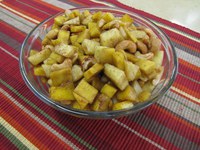Prairie Fare: Pets’ Weight Gain Provides Lesson
(Click an image below to view a high-resolution image that can be downloaded)
By Julie Garden-Robinson, Food and Nutrition Specialist
NDSU Extension Service
As I admired a dog on a leash at the pet store, her owner said, “She just had a haircut. I thought she had gotten fluffier over the winter. You can see she’s a little too chubby.”
Just like people, pets increasingly are becoming overweight or obese. Being overweight can promote a variety of diseases that include heart disease, hypertension, diabetes and cancer, as well as joint issues.
I noticed two of our three dachshunds were “fluffier” this spring, too. However, our dogs have short, smooth hair, so a haircut wouldn’t make them appear slimmer. When I looked down at them, I noticed they did not have a “waist” as dachshunds should.
Our “wiener dogs” looked more like stuffed sausages, and their pot bellies were getting closer to the ground. I knew exactly what had happened. They did not want to be outside longer than necessary during the cold winter months. They also know how to use their pleading eyes to get extra food, such as my peanut butter toast in the morning.
OK, I need to resist their soulful brown eyes and whining.
At that moment, I decided to begin the intervention. As with humans, “energy in and energy out” must be in balance to avoid weight gain. We all want our pets to live long and healthy lives.
I picked up miniature dog treats with only 10 calories per treat. I examined the packages of calorie-controlled dog food but decided to opt for portion control. We cut back their portion size by about one-third. We also separated them while they ate because Jake, the dominant (and heaviest) dog, finishes eating quickly and tries to eat the others’ food.
We found their toys and played fetch and they raced our neighbor’s dogs along the fence. We found their harnesses and leashes and took them on walks.
Jake stopped midway during our two-mile walk and refused to continue. Did I mention that he is stubborn? So, I carried him awhile and then set him down to walk. Did I mention that I am persistent?
As our dogs have become more slender, their energy level has increased. They nearly are at their recommended weight, but we need to be sure the environment we are providing promotes good health.
Obesity and being overweight are in the news again. According to the latest report from the Institute of Medicine, two out of three adults and one out of three children are overweight or obese. About $190 billion is spent annually on obesity-related illnesses.
Collectively, our average calorie consumption increased from 1,996 calories per day in the early 1970s to 2,234 calories by 2005. Keep in mind that eating 100 calories more than you need can result in a 10-pound weight gain in a year.
Managing the weight of our pets turned out to be fairly straightforward; we put less food in their bowls and made exercise fun. However, as numerous studies have shown, conquering the obesity issue for people is far more complex.
The strategies go beyond what we do as individuals because food and messages about food are all around us, and options for physical activity are not necessarily readily available. Physical activity needs to be a routine and integral part of our life regardless of our age.
Our environment, whether we are at home, work, school, at a restaurant or anywhere else, needs to support healthful food choices. Food marketing and government policies impact our food choices. You can learn more about key methods to help prevent obesity by visiting http://www.iom.edu/acceleratingobesityprevention.
If you are trying to avoid becoming “fluffier,” be aware of the calorie content of your food choices by reading Nutrition Facts labels. Adding more fiber-containing foods, such as fruits and vegetables, to your diet will help you feel full. Here’s a recipe featuring fiber-rich mangoes and apples; cinnamon enhances their natural sweetness. For more recipes and tips about food and fitness, visit http://www.ndsu.edu/eatsmart.
Apple Mango Salad
1 mango, peeled, seeded and cubed (or substitute pear)
1 Granny Smith apple, peeled, cored and diced
3/4 c. toasted cashews
1 Tbsp. balsamic vinegar*
1/2 tsp. ground cinnamon
1/4 tsp. ground ginger
1 pinch salt
(* You can substitute 1 Tbsp. red wine vinegar and 1/2 tsp. sugar.)
In a medium bowl, toss together mango, Granny Smith apple, cashews, balsamic vinegar, cinnamon, ginger and salt.
Makes six servings. Each serving has 140 calories, 8 grams (g) of fat, 3 g of protein, 15 g of carbohydrate, 1 g of fiber and 50 milligrams of sodium.
(Julie Garden-Robinson, Ph.D., R.D., L.R.D., is a North Dakota State University Extension Service food and nutrition specialist and associate professor in the Department of Health, Nutrition and Exercise Sciences.)
NDSU Agriculture Communication – May 10, 2012
| Source: | Julie Garden-Robinson, (701) 231-7187, julie.garden-robinson@ndsu.edu |
|---|---|
| Editor: | Rich Mattern, (701) 231-6136, richard.mattern@ndsu.edu |




